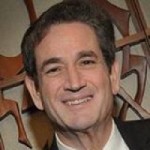By Rabbi Ben Kamin

ENCINITAS, California — On June 21, 1964, David Goodman was a teenager living in his family’s Manhattan apartment. He noticed his mother pacing nervously: another of her sons, Andy, just 20 years old, was missing somewhere in Mississippi. David was anxious and frightened as well.
It was the “Freedom Summer”—during which 1,000 volunteers (“50% Jewish, 50% Christian,” Goodman points out) converged upon the sweltering and violently segregated bastion-state and attempted to galvanize national attention on the glaring lack of access to voting booths suffered by black people. At least three of these idealists paid with their lives.
History would bitterly document that Andrew Goodman, along with a fellow Jewish activist named Michael “Mickey” Schwerner, as well as their African American colleague, James Chaney, were brutally murdered overnight by Ku Klux Klansmen. Their withered bodies were found in an earthen dam there in Neshoba County 44 days later.
I spoke with David Goodman recently as he was making his way, via Washington DC, to the 50th anniversary commemoration in Selma, Ala., of the famed March for voting rights. Goodman was connecting in Washington with Congressman John Lewis—the hands-on leader of the Selma campaign—and then joining President Obama and a number of civil rights icons for a series of events and rallies in the vicinity of the notorious Edmund Pettus Bridge.
Philosophical, energetic, passionate, gracious, David Goodman has never gotten off the bridge that leads to social justice and racial equality. The scion of New York civic contractors, engineers who constructed the city’s tunnels and bridges, he is still building coalitions—burrowing through what he terms “voter contraction” as opposed to voter expansion, admonishing minority groups to recall and rebuild the “stunning success” of the one-time “coalitions, minorities with millions of people who came together in collective self-interest.”
He speaks with first-hand knowledge about the “magnitude”of power in creating political action groups actually based in diversity. He is candid about the process as well: “You think the Irish and the Italians and the Jews always liked each other? There was a lot of yelling and screaming at those meetings. But we knew that if we formed partnerships, and especially if we included minorities, we’d be working with a vision that goes as far back as Jamestown, 1619. And the civil rights movement then was a coalition that got the attention of the President.”
Speaking in the era of Ferguson, recalling a time when Americans reached across ethnic lines—even when the groups were improbable allies—Goodman has no patience for platitudes and no tolerance for inaction.
“We’re not going to change squat if we just sit in our tribal corners,” he said. “We will get nowhere fast.”
I asked Goodman what his brother Andy might have thought if he were alive today. Self-effacingly, Goodman immediately replied, “I really couldn’t guess and it’s hard, of course to speak for someone else.” With a touch of irony, Goodman said that “Andy was not particularly political.”
Goodman recalled Andrew’s interest in and concern for a group of struggling, poverty-stricken, non-unionized coal miners who toiled in West Virginia. “He was just 15,” said David. “It wasn’t complicated for him. “
So off went the young man to the hills of West Virginia, where he interviewed the soot-covered underground workers, visited with their families, and prepared a report for dissemination by the powerful union forces in his native New York.
“He just asked himself, what could he do about it? It wasn’t complicated.”
Andrew Goodman joined the Student Non-Violent Coordinating Committee (SNCC) when he was a junior at Queens College. In 1964, he told his parents that he was going to Mississippi. Fifty years later, his mother, Carolyn Goodman told The New York Times: “It wasn’t easy for us. But we couldn’t talk out of both sides of our mouths. So I had to let him go.”
This weekend, David Goodman will speak at a synagogue in Selma. “It’s all well and good to remember fifty years,” he told me. “My goal is to put it forward into new partnerships. We need to participate. When you participate, you create a learning community.”
David Goodman and his family learned the hard way. But what they all have done is teach.
*
Rabbi Kamin is an author of several books on the U.S. Civil Rights Movement. He may be contacted via ben.kamin@sdjewishworld.com, or you may publicly post a comment, as per below.
__________________________________________________________________
Care to comment? San Diego Jewish World is intended as a forum for the entire Jewish community, whatever your political leanings. Letters may be posted below provided they are civil, responsive to the article that prompted them, and signed with your first and last name, as well as with your city of residence. There is a limit of one letter per writer on any given day.
__________________________________________________________________